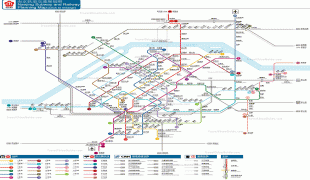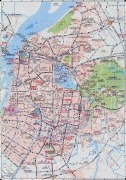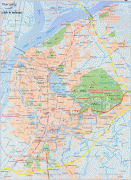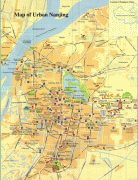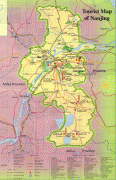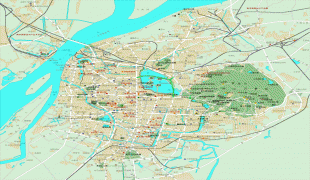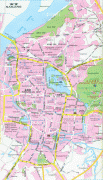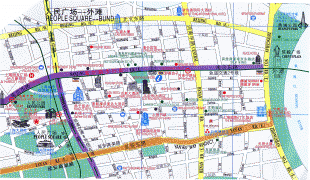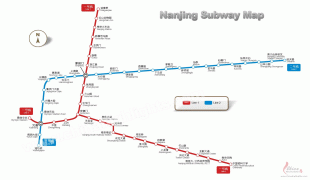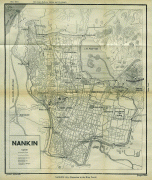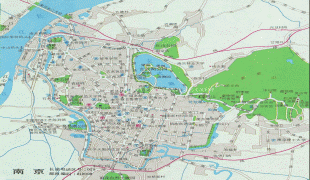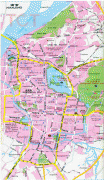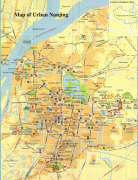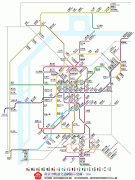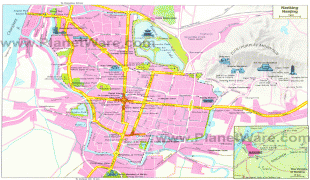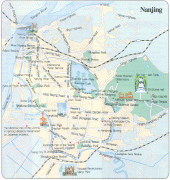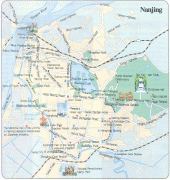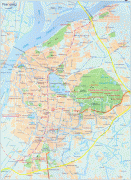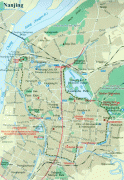Nanjing
 |
 |
Situated in the Yangtze River Delta region, Nanjing has a prominent place in Chinese history and culture, having served as the capital of various Chinese dynasties, kingdoms and republican governments dating from the 3rd century to 1949, and has thus long been a major center of culture, education, research, politics, economy, transport networks and tourism, being the home to one of the world's largest inland ports. The city is also one of the fifteen sub-provincial cities in the People's Republic of China's administrative structure, enjoying jurisdictional and economic autonomy only slightly less than that of a province. Nanjing has been ranked seventh in the evaluation of "Cities with Strongest Comprehensive Strength" issued by the National Statistics Bureau, and second in the evaluation of cities with most sustainable development potential in the Yangtze River Delta. It has also been awarded the title of 2008 Habitat Scroll of Honor of China, Special UN Habitat Scroll of Honor Award and National Civilized City. Nanjing is also considered a Beta (global second-tier) city classification, together with Chongqing, Hangzhou and Tianjin by the Globalization and World Cities Research Network, and ranked as one of the world's top 100 cities in the Global Financial Centres Index.
Nanjing has many highly ranked educational institutions, with the number of universities (13) listed in 147 Double First-Class Universities ranking third (after Beijing and Shanghai), including Nanjing University, which has a long history and is among the world's top 20 universities ranked by Nature Index. The ratio of college students to the total population ranks No.1 among large cities nationwide. Nanjing has the eighth-largest scientific research output of any city in the world. As of 2022, it has been regarded as the world's top second scientific research center in earth & environmental sciences after Beijing and the world's top third scientific research center in chemistry (behind Beijing and Shanghai), according to the Nature Index.
Nanjing, one of the nation's most important cities for over a thousand years, is recognized as one of the Four Great Ancient Capitals of China. It has been one of the world's largest cities, enjoying peace and prosperity despite wars and disasters. Nanjing served as the capital of Eastern Wu (229–280), one of the three major states in the Three Kingdoms period; the Eastern Jin and each of the Southern dynasties (Liu Song, Southern Qi, Liang and Chen), which successively ruled southern China from 317 to 589; the Southern Tang (937–75), one of the Ten Kingdoms; the Ming dynasty when, for the first time, all of China was ruled from the city (1368–1421); and the Republic of China under the nationalist Kuomintang (1927–37, 1946–49) before its flight to Taiwan by Chiang Kai-Shek during the Chinese Civil War. The city also served as the seat of the rebel Taiping Heavenly Kingdom (1853–64) and the Japanese puppet regime of Wang Jingwei (1940–45) during the Second Sino-Japanese War. It suffered severe atrocities in both conflicts, most notably the Nanjing massacre of 1937.
Nanjing has served as the capital city of Jiangsu province since the establishment of the People's Republic of China. It has many important heritage sites, including the Presidential Palace and Sun Yat-sen Mausoleum. Nanjing is famous for human historical landscapes, mountains and waters such as Fuzimiao, Ming Palace, Chaotian Palace, Porcelain Tower, Drum Tower, Stone City, City Wall, Qinhuai River, Xuanwu Lake and Purple Mountain. Key cultural facilities include Nanjing Library, Nanjing Museum and Jiangsu Art Museum.
The city has a number of other names, and some historical names are now used as names of districts of the city; among them there is the name Jiangning, whose first character Jiang (, i.e. the Yangtze) is the former part of the name Jiangsu and second character Ning (寧, simplified form ) is the shortened name of Nanjing. When it was the capital of China, for instance under the ROC, Jing was adopted as the abbreviation of Nanjing.
The city first became a Chinese national capital as early as the Jin dynasty. The name Nanjing, which means "Southern Capital", was officially designated for the city during the Ming dynasty, about six hundred years later. Nanjing is sometimes known as Jinling or Ginling (金陵, "Gold Hill") of the eponymous Ginling College; the old name has been used since the Warring States period in the Zhou dynasty. In English, the spelling Nanking was traditional until Pinyin, developed in the 1950s and internationally adopted in the 1980s, standardized the spelling as "Nanjing".
Map - Nanjing
Map
Country - China
 |
 |
| Flag of China | |
Modern Chinese trace their origins to a cradle of civilization in the fertile basin of the Yellow River in the North China Plain. The semi-legendary Xia dynasty in the 21st century BCE and the well-attested Shang and Zhou dynasties developed a bureaucratic political system to serve hereditary monarchies, or dynasties. Chinese writing, Chinese classic literature, and the Hundred Schools of Thought emerged during this period and influenced China and its neighbors for centuries to come. In the third century BCE, Qin's wars of unification created the first Chinese empire, the short-lived Qin dynasty. The Qin was followed by the more stable Han dynasty (206 BCE–220 CE), which established a model for nearly two millennia in which the Chinese empire was one of the world's foremost economic powers. The empire expanded, fractured, and reunified; was conquered and reestablished; absorbed foreign religions and ideas; and made world-leading scientific advances, such as the Four Great Inventions: gunpowder, paper, the compass, and printing. After centuries of disunity following the fall of the Han, the Sui (581–618) and Tang (618–907) dynasties reunified the empire. The multi-ethnic Tang welcomed foreign trade and culture that came over the Silk Road and adapted Buddhism to Chinese needs. The early modern Song dynasty (960–1279) became increasingly urban and commercial. The civilian scholar-officials or literati used the examination system and the doctrines of Neo-Confucianism to replace the military aristocrats of earlier dynasties. The Mongol invasion established the Yuan dynasty in 1279, but the Ming dynasty (1368–1644) re-established Han Chinese control. The Manchu-led Qing dynasty nearly doubled the empire's territory and established a multi-ethnic state that was the basis of the modern Chinese nation, but suffered heavy losses to foreign imperialism in the 19th century.
Currency / Language
| ISO | Currency | Symbol | Significant figures |
|---|---|---|---|
| CNY | Renminbi | ¥ or 元 | 2 |
| ISO | Language |
|---|---|
| ZH | Chinese language |
| UG | Uighur language |
| ZA | Zhuang language |






